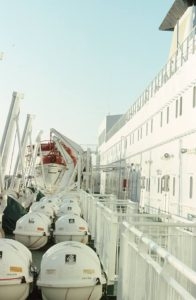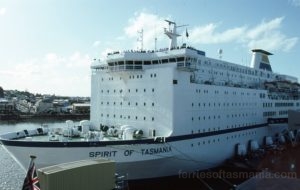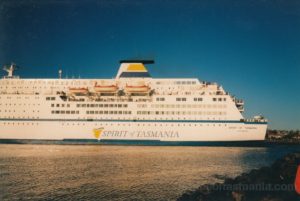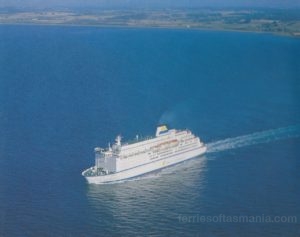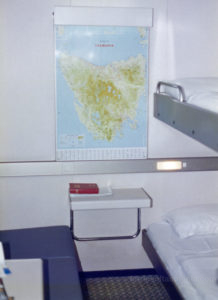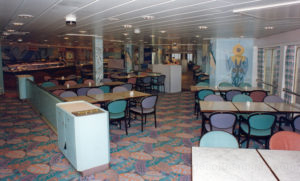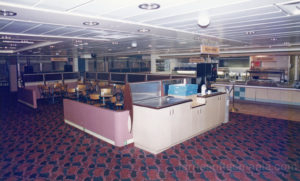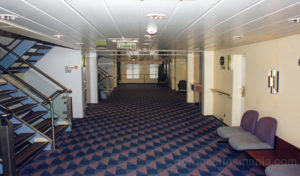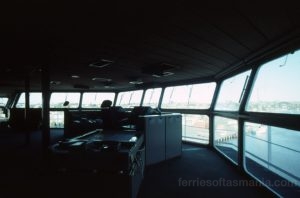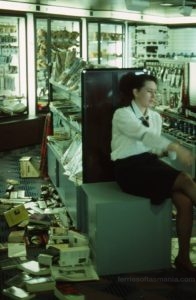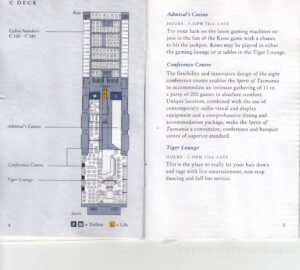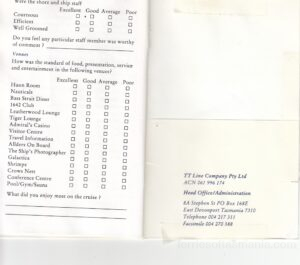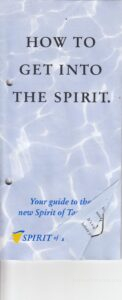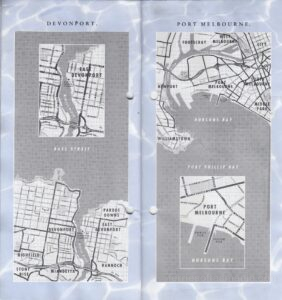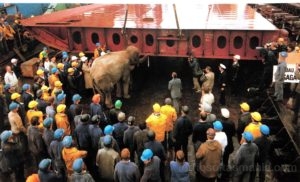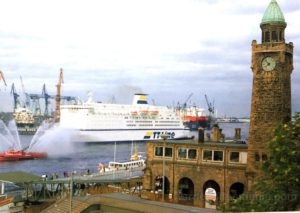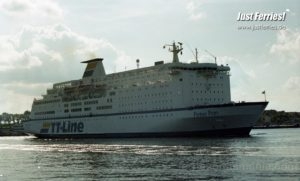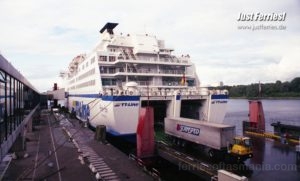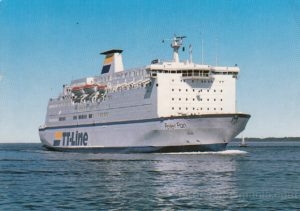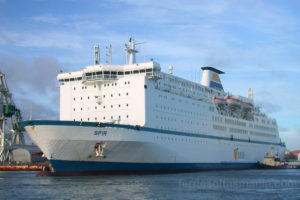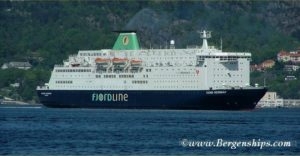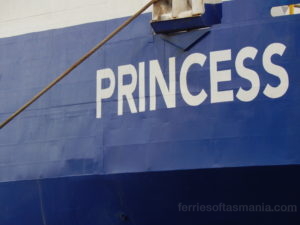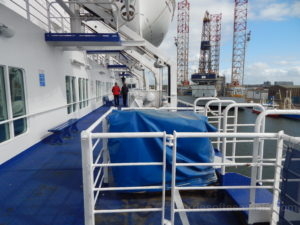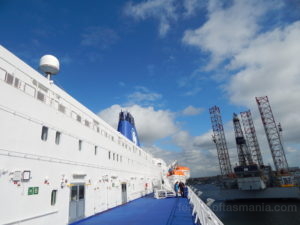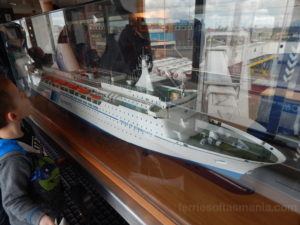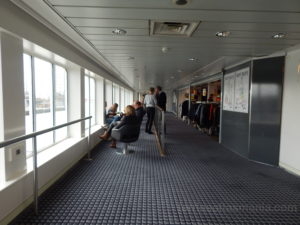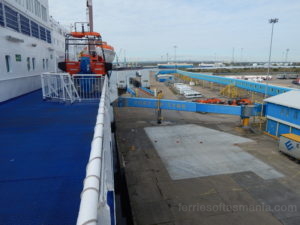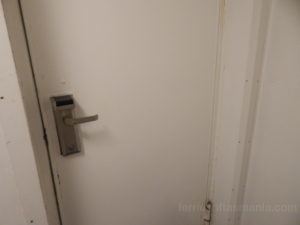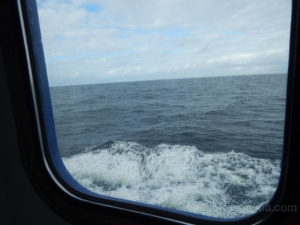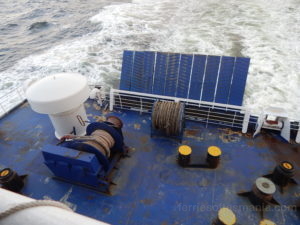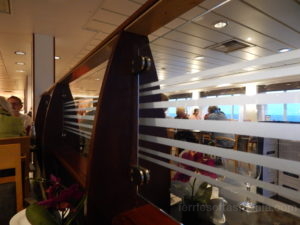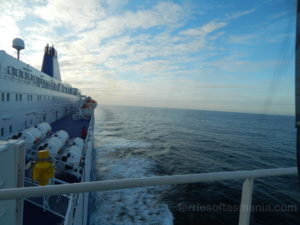
Photo: Stephen Gatt collection.
Builder: Seebeckwerft A.G, Bremerhaven Germany.
Year of build: 1986
Ship yard number: 1058.
IMO Number: 8502391
Call sign: VNGY
Length: 162.52m.
Width: 27.6m.
Daft: DWL 6.21m / Scantling: ?m.
GT/ NT/ DWT. 31356t/ 16200t/ 4110t
Main engines. Four MaK 8M552 Diesels.
Power rating: 19600 kW.
Gear ratio: ? rpm to ?rpm.
Service speed: 18 knots (21 max)
Passengers capacity: 1324 beds in 468 cabins.
Cars: 360
Trailers: 35
Total Lane meters: 1,400m
Spirit of Tasmania sailed on the Bass Strait between 1993 and 2002. She was built at Seebeckwerft A.G in Bremerhaven Germany as Peter Pan in 1986, for the TT-Line of Germany. She was the third ship to wear that name. She was ordered in late 1984, along with a sister ship, Nils Holgersson. (Successor to the Nils Holgersson that became Abel Tasman) Her keel was laid at a ceremony on 9/7/1985. As a publicity stunt, TT-Line had an elephant from a local zoo place the traditional lucky coin down before the keel was laid on it. The idea behind this was the Peter Pan and Nils Holgersson were to be known as “Jumbo” ferries, so thought this was a nice idea for publicity. On the 30/11/85 Peter Pan was launched down the slipway. During the next six months work continued to finish her, whilst Nils Holgersson’s hull was under construction in the building hall. Peter Pan was handed over to TT-Line on 30/5/1986. She sailed to Hamburg, her port of registry for a promotional visit and open day. After which she sailed to Travemünde to commence operations to Trelleborg, making her maiden voyage at 10pm on 2/5/1986.

Scan: Carsten Watsack, Just Ferries! collection.
Peter Pan represented a large step forward in luxury and technology over her predecessors. One such feature, she was the first passenger ship world wide to have magnetic cards to open cabin doors, a standard feature used on passenger ships now days. Peter Pan was joined by her sister Nils Holgerson on the Travemünde- Trelleborg line on 26/2/1987. Nils Holgersson was owned by the Swedish partners Rederi AB Swedcarrier, and Peter Pan by the Germans. Nils Holgersson was sold prior to delivery, to Wallenius lines and chartered back to the Swedish partner, in a move to raise capital for the Swedish partners to commission more new builds for the TT-Line partnership. The German owners of TT-Line also owned the Olau Line, which operated between England and the Netherlands. They commissioned the building of another pair of sister ships, very similar to the Peter Pan and Nils Holgersson. It was the intention of TT-Line to place the two new builds on the Travemünde- Trelleborg line, and place the former two on the Sherness (UK) – Vlissingen (Netherlands) line, but this plan was later canned and the new ferries, were to go to Olau Line, later named Olau Hollandia and Olau Britannia.

Photo: © Carsten Watsack, Just Ferries! (Used with permission)
In 1986 the Peter Pan, along with her sister enjoyed great success, so much so TT-line investigated the possibility of having them “stretched” by adding a section in the middle to increase passenger and freight capacity, but this never eventuated.

Photo: © Carsten Watsack, Just Ferries! (Used with permission)
After the falling of the Berlin wall, the iron curtain gone and increased competition on the Sweden – Germany trade, there were uncertain times ahead for TT-Line. Even though business was still going well at the time, they felt they needed to make make a move to stay ahead of the game. In 1990 Transport Tasmania had been had been seeking to replace the Abel Tasman, but had found nothing in Europe big enough that was available to buy. TT-Line received a call from a ship broker offering them a Norwegian ferry, but it was found not to be suitable for the Bass Strait operation. The call indirectly led to the negotiations between them and TT-Line of Germany, whom they brought the Abel Tasman off six years earlier who . On Christmas eve of 1990 it was announced they had purchased the Peter Pan for AUD$150 million, more than the construction price some four years earlier. The handover was agreed upon for three years later. In 1992 the Swedish partners had arranged to sell also the Nils Holgersson to Brittany Ferries, in the January of 1993.
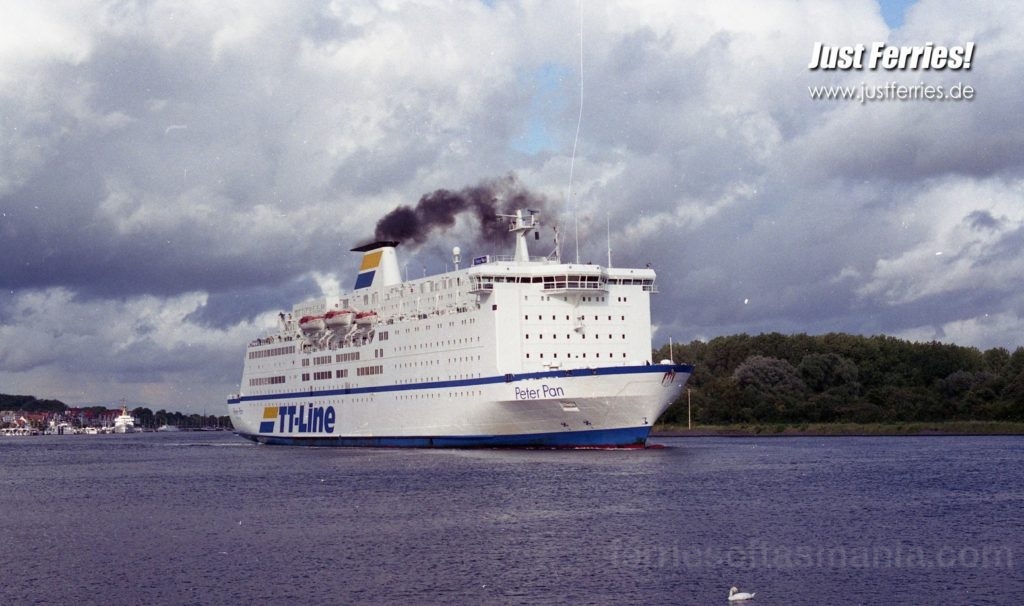
Photo: © Carsten Watsack, Just Ferries! (Used with permission)
From January 1993 Peter Pan ran in tandem to a charted ship, the former Peter Pan of 1974, the Abel Tasman’s sister ship Fedra for a few months until the delivery of her rebuilt replacement.
TT-Line Germany had pushed back the original hand over of date of Peter Pan by some time, since TT-Line of Tasmania had initially agreed to purchase Peter Pan. This was due to needing her until they had received their own ships to replace her.
Finally on the 1/9/93 the long awaited day finally came for the hand over of Peter Pan. Some crew had flow out from Australia to join the Peter Pan in Travemünde, where the next Peter Pan (4) was ready to replace her.
She sailed down the Trav where she blasted her horn three times, with the Tasmanian flag proudly hoisted on the bow. Her destination, Lloyd Werft shipyard in Bremerhaven

Photo: © Carsten Watsack, Just Ferries! (Used with permission)
When Peter Pan left, a local German newspaper had the following article, Translation by Carsten Watsack:
“7 years and 3 months on the line Travemünde-Trelleborg
On the morning of 01.09.93 the last passengers disembarked.
Afterwards everything was packed – from the travel brochure to the bottle of schnapps in the shop.
Since 1986 the ship has made 2745 round trips between the two ports. It covers 1.2 million kilometers. 134000 tons of fuel were needed. 3.5 million passengers were on board. 2.5 million liters of beer were consumed, 15 tonnes of salmon, 19 tonnes of fillet of beef, 4.2 million rolls, 1.8 million eggs. Water consumption was 400 million liters. The captain says there has never been a serious breakdown. The market value of the ship is far above the construction costs of the ship, that was 150 million German marks.
On 03.09. the flags were changed in Bremerhaven, from here on the ship is called SPIRIT OF TASMANIA. The conversion work and the training of the Australian crew will take 4 weeks. Only then the journey will start, which will take one month. The German captain remains on board until Las Palmas or Cape Town and helps the Australian crew.”

Photo: © Carsten Watsack, Just Ferries! (Used with permission)
Peter Pan arrived at Lloyd Werft ship yard on 2/9/93 after passing through the Kiel Canal. She was placed into the dry dock, and after inspections officially handed over to TT-Line of Tasmania, on 3/9/93. She remained at the ship yard for almost a month, whilst many of the machinery was fixed up, and slight remodeling to the interiors. As with the Abel Tasman, the machinery was found to be in a poor state, but limited time and tight budget meant she must sail for Tasmania to begin operations for 29th of October. The Germans had told the Australians that one of the fin stabilizers needed attention, but the Australians ignored them, because they were running on a tight budget. This later caused a lot of problems and failed in Tasmania, so had to be fixed/exchanged at a dry docking later on.
I am told the mood between the Australians and Germans was good during the dry docking and subsequent works on Abel Tasman eight years earlier, but this time the Australians weren’t so friendly, possibly because of the sate the vessels were in and the high price paid for the Peter Pan.

Scan: Mitchell Bruce collection, © Simplon postcards
On the 5/10/1993 Spirit of Tasmania left Germany bound for Tasmania. She sailed across the Bay of Biscay, past Spain, but unlike the Abel Tasman continued south and didn’t go via the Med and Suez. She called at Las Palmas on the Canary island for Bunkers. She continued down the west coast of Africa bound for Cape Town, where she called again to take on bunkers. She set off across the Indian ocean for Fremantle, for Bunkers. Continuing she arrived in Devonport 12 November to great fan fare, 100os of people lined the banks of the Mersey River to catch a glimpse of the new Spirit of Tasmania.
I personally recall this event, as a small child waving to the new Spirit of Tasmania with yellow and blue TT-Line flag as she came up the river.

Photo: Stephen Gatt collection.
Spirit of Tasmania remained in Devonport for a couple of weeks, for crew training, final fitting out and stocking of shops etc to be done. On 25/10/1993 Spirit of Tasmania sailed from Devonport to Hobart, for a promotional visit. She anchored off Bellerive oval 26/11/1993, where an international cricket match was being played between Australia and New Zealand. Well know Australian Cricket player from Tasmania, David Boon commented he might have to take the ship on a a mascot, as it was the day he scored a hundred in Hobart. He later had a luxury suite onboard named in his honer.

Scan: Mitchell Bruce collection, © Tasmanian book company
Spirit of Tasmania departed Hobart and sailed back to Devonport, were she docked 27/11. That night, shortly after Abel Tasman departed Devonport for the very last time, bound for Melbourne, Spirit of Tasmania also departed for Melbourne to begin operations. As she entered Port Philip Bay, Abel Tasman was waiting for her, so they could sail up the Bay together, and “Hand over the baton” so to speak. Spirit of Tasmania arrived in Melbourne to water cannons being sprayed, to celebrate her arrival. She docked at No.1 inner east berth (TT-Line’s berth) at station pier, with the now finished Able Tasman on the opposite side. She was now ready to enter service. She departed the next day 29/11/1993 at 6pm for her maiden voyage to Devonport. Onboard the three conference rooms were named after old ferries from the Bass Strait, being the Princess of Tasmania, Taroona and Nairana. The only difference to the timetable was, the layover now was Sunday night in Melbourne, and not Saturday night in Devonport like the Able Tasman.

Photo © Worlddiscoverer
Spirit of Tasmania settled into her new routine of sailing Devonport to Melbourne. In May 1994, TT-Line decided they would try and utilize the Spirit of Tasmania during her Sunday night layover in Melbourne. They started 4 hour evening “Sun Set Bay cruises” around the port Philip Bay. These proved quite popular. Later in 1994 they also started with afternoon cruises, where lunch was served onboard, but these weren’t as popular as night trips. On a few occasions, She did longer cruises, where she left the bay and headed along the coast down to Cape Otway , but this was stopped, as the sea was to rough close to the coast in shallow waters.

Photo © Worlddiscoverer
By 1995 the Spirit of Tasmania was sailing at capacity in the summer months, and usually with the garage decks full of freight, extra to passengers cars. TT-Line officials went to Europe to inspect the sister vessels to Spirit of Tasmania, the former Olau Hollandia and Olau Britannia of 1989 and 1990, now know as Pride of Portsmouth and Pride of Le Havre. Due to complicated political crewing issues, the German TT-Line had disbanded the Olau Line operation in 1994. They had then charted the two ships to P&O ferries for service between France and England. TT-Line of Tasmania were looking to buy one of these vessels, to run with the Spirit of Tasmania, it was to be named Spirit of Bass Strait, but they could not secure any funding form the federal government so it never materialized.

Photo: Stephen Gatt collection.
The Bass Strait is know to be a very rough stretch of water at times. On one voyage the seas were very rough, one wave in particular so large it stopped the ship dead from 17 knots in just a moment. So severe it bent all the plating on the bow. On another crossing the ship had rolled to such a degree a lot of stock fell from shelves in the shops and restaurants fell to the floor and some stuff not properly secured it fell.

Photo: Stephen Gatt collection
In July of 1995 Spirit of Tasmania went to Newcastle (The one in Australia) for her bi annual dry docking. During this time there were some alterations made to the ship internally, like increasing the restaurant size by making a cafe part of the space, among other refurbishments. Spirit of Tasmania was floated out of the dry dock 11/8/95 and sailed strait back to Melbourne to recommence her trade. In September of 1996 the federal government launched the Bass Strait Passenger Vehicle Equalisation Scheme. This is basically a subsidy to transport private cars across Bass Strait, making it much cheaper for passengers. In winter it was as cheap as AUD $25 to take a passenger car across the Strait. This resulted in more passengers and their cars sailing on the Spirit.
In July 1997 Spirit of Tasmania sailed to Sydney, for dry docking. It was the first time she had visited the city. On 15 of July Spirit of Tasmania entered the dry dock and was there until 25 July, when she was re floated and headed back to Melbourne. Whilst she was away, TT-Line had charted Incat 045, a vessel from Incat Tasmania ship builders, to evaluate the possibility of running a fast craft on a more permanent bases.
To try and cope with demand during the 1997-98 summer peak season, TT-Line made a new schedule for Spirit of Tasmania, where she would leave Devonport 4pm on Saturdays, arrive Melbourne 5am Sunday, Depart 9am arrive Devonport 10pm, Depart 2am Monday morning arrive Melbourne 3pm then depart at 8pm arrive Devonport 9am, thus enabling 2 extra sailings a fortnight.
With demand so high, TT-Line charted a another fast craft from Incat Tasmania, Incat 046 dubbed The Devil Cat, after the Tasmanian devil.
During July of 1999 Spirit of Tasmania again sailed to Sydney for dry docking for two weeks. she resumed her route 4/8, During her absence there had been no replacement on the line.

Scan: Mitchell Bruce collection, © Nucolorvue Productions.
On 4/9/99 Spirit of Tasmania departed Devonport at 4pm, ready for the first of her extra sailings during school holidays. After a few hours into the voyage, there was a series of crankcase explosions over a period of time. It was decided to shut three of the four engines down to prevent even further damage. The Spirit sailed back into Devonport on only one engine, No.4 Eng. All passengers, vehicles and trailers had to be off loaded. Engineers started to pull the engines down to find out what was wrong. They found scouring on the pistons and liners with metal shaving in the oil, among other damage. Parts had to be flown from the engine manufacturer Mak, in Germany. After the failure TT-Line had to charter aircraft to fly passengers home in both directions. TT-Line were able to secure a charter of Condor 10, a fast catamaran built by Incat, which had been laid up in New Zealand at the time. It could not began service until she sailed to Australia and acquired certification to began operations. She sailed from Wellington at about midnight 9/9/99 to dash to Australia. In the mean time Holymans and Brambles ships had been helping out by filling any spare space on their Ro/Ro ships with the passengers cars who had flown across. TT-Line were able to secure the charter of a car carrier, Turandot from Wallenius lines of Sweden. She was docked in Melbourne, delivering new cars from Europe. After discharging her cargo at the Melbourne Ro/Ro terminal, she proceeded to Station pier to take on cars bound for Tasmania. She set sail 11/9/99 for Devonport. Once in Devonport she discharged, then loaded for Melbourne, arriving back there later on the 12/9. The next day, after discharging the cars for TT-Line she headed for Sydney to continue delivering her cargo of new cars. Condor 10 arrived in Melbourne 11/9 and departed with cars and passengers the next morning. On 21/9 Spirit of Tasmania was fixed and resumed service that day, with Condor 10 heading back to Incat in Hobart. The break down cost TT-Line about AUD $8.8 million, with the charter of the two substitute vessels and flying passengers across the strait, as well as parts from Germany.
The 1999 Summer season TT-Line signed a charter agreement with Bay ferries of Canada, to charter Incat 045 for the next 3 summer seasons, dubbed the Devil Cat again. The summer season was so busy Spirit of Tasmania had to revert to her extra sailings schedule to cope with demand, even with the Devil Cat running.

On the 23/2/2001 Spirit of Tasmania departed Melbourne at 18:00 with 967 passengers, 112 crew and 10 staff from onboard franchise shops etc. At 01:14 the fire monitor panel indicated a pre warning, for a fire in The Ship’s Photographer shop at the aft of E deck. About a minute later it alarmed on the bridge, shortly followed by another detector in the same room. The duty mate on the bridge radioed the night patrol to check it out ASAP.
It was confirmed there was a blaze at the rear of the shop. The mate then called the captain and stared the muster alarm in the crew accommodation. At 01:20 the captain made the decision that the fire was serious based on the info he was receiving, and initiated the muster alarm throughout the whole ship, calling all passengers to muster stations. By this time the emergency attack team had assembled at the front of the shop, Two integrated ratings were nominated to put on breathing apparatus and enter the shop to put out the fire. At 01:25 the mate called the bridge to activate the closing of fire doors throughout the ship remotely, to stop the spreading of smoke. The two integrated ratings entered the shop with thick smoke, but managed to locate the fire. They attempted to put it out with hand held extinguishers, but it kept re reigniting. It was decided the only way to put it out would be with a fire hose. So the fire hose was readied and the Integrated ratings re-entered and the fire successfully put out using sea water. At 01:44 the fire was declared out. By this time all passengers had been assembled at the muster stations. A lot of smoke had spread through the cabins, so passengers were kept at the muster stations for an hour for the smoke to clear and in case the fire had reignited, which was being monitored by crew. By 02:55 it was decided to allow passengers back to there cabins. Spirit of Tasmania arrived in Devonport on schedule in the morning of 24/9/01

Photo: © Mitchell Bruce
In May of 2002 TT-Line announced they had Purchased Superfast III & IV from Greek company Attica Enterprises to replace the Spirit of Tasmania and the Devil Cat. At 4pm on 31/8/2002 under the command of Capt Stephen Major, Spirit of Tasmania departed Devonport for Melbourne, the final time. Thousands of people lined the banks of the Mersey River to farewell the much loved ship. During the voyage there were many festivities, even a couple even got married onboard. The Spirit arrived at station pier at 5am 1/9/2002, having crossed Bass Strait 2,849 times, carried a total of 2.3 million passengers, 807,000 cars and 185,000 TEUs. Spirit of Tasmania moved off No.1 inner east berth to swap with the new Spirit of Tasmania II, so she could commence operations. After de-stocking Spirit of Tasmania sailed up to Sydney harbor on 5/9, arriving on 7/9, where she was laid-up, first at Garden Island, then to White Bay. The vessel had been inspected by a few potential buyers, but nothing materialized. On 16/12/02 Spirit of Tasmania departed Sydney with representatives from Fjord line of Norway onboard and headed out to sea. For some reason the sale had to be finalized with the ship out in international waters. The price was EUR €51.5, approx AUD $61 million. She came back into Sydney and docked at White Bay the next day. Over the next few days she was readied for the voyage back to Europe, as well as the painting out of the name on the ship, renaming her Spir for the delivery voyage to Denmark.

Photo: © Søren Lund Hviid.
On Christmas eve 2002 (Same day she was sold to Tasmania by the Germans some twelve years earlier) she sailed out of Sydney harbor, blowing her horn three times as she passed under the Sydney harbor bridge and the opera house. She headed south, down the east coast, through her old stomping ground of the Bass Strait one final time, and onto Fremantle for Bunkers, arriving 30/12/02. She departed a few hours later heading across the Indian Ocean to Colombo, again for bunkers. Then onto the Gulf of Aden, Red Sea, then transiting the Suez canal. She then continued her voyage through the Mediterranean sea, then northward through the English channel and North Sea finally arriving at Frederikshavn in the north of Denmark on 28/1/03, to be refitted at Orskov yard. On the Voyage from Sydney there had been a few Australian technicians remain with the vessel, to help the Norwegian crew out. Indeed on the voyage much work was being done, stripping the interiors of the ship, to save time once she arrived at Orskov yard. During the dry docking, many of the public spaces were remodeled and or refurbished. Included in the works were an upgraded bow thruster, to deal with the high winds in Hanstholm. Another addition was the “Down Under Pub”, perhaps a tribute to her Australian career. The works cost approx EUR€ 10 million. After a month, she left Frederikshavn and headed to Bergen for her inauguration and christening ceremony, arriving there in the morning of 3/4/03. Her new name was covered over, as to be a surprise. During the ceremony she was officially renamed Fjord Norway, registered in Bergen Norway.
A few days later on the 8/4 she made her maiden voyage south, on her new route from Bergen to the Norwegian coastal towns of Haugesund and Egersund and onto the Danish town of Hanstholm, and back.

© Eric Ask, Bergenships.com
On 21/12/2003 Fjord Norway was leaving Hanstholm in heavy winds, but somehow a mooring line hadn’t been heaved all the way in yet, and it got drawn into the bow thruster jamming it up. Due to the winds the ship could not pull herself away, so remained in the port until a tug could come the next day to pull her off. The next day she continued her journey after the tug pulled her away.
In September of 2005 Fjord line sold one of their ferries, the Jupiter which had been employed on the Bergen-Newcastle (UK) route. It was decided that Fjord Norway should replace her, and their other ship, Bergen which was returning from a Charter to DFDS Seaways, would in turn replace Fjord Norway on her route. On 3/11/05 she made a trial run from Bergen, down to Stavanger and then across the North Sea to Newcastle upon Tyne. It was deemed a success, so from 17/11/05 she was deployed on this trade, being the longest run she had been on in her life at about 450 nautical miles each way.
In September of 2006 DFDS Seaways agreed to purchase Fjord Norway and the Norway to England route. 12/10 she arrived in Bergen, then sailed to Frederikshavn to be docked at Orskov yard for repainting into DFDS colours and refitted. On 16/10 she was officially handed over to DFDS Seaways, renamed Princess of Norway and regested in “København” (Copenhagen) Denmark. On 6/11 she sailed back to Bergen, arriving on the 8/11. There was a ceremony that day, and then on the 9/11 she departed to take up her trade of Bergen-Haugesund-Stavanger-Newcastle route.

© Eric Ask, Bergenships.com
In 2006 DFDS Seaways decided to send Princess of Norway on a 3 day “New years cruise”. She departed Bergen 30/12/06 bound for Gothenburg in Sweden, she arrived there that evening for passengers to enjoy the celebrations, with the ship docked as accommodation. (It was the first time she’d been back to Sweden since she left for Australia). The next day passengers were free to explore the city. That night she departed and sailed back to Bergen, and resumed her run back to Newcastle.
A couple of weeks later she sailed to Orskov yard, in Frederikshavn once again, to have annual maintenance and refit, arriving 22/1/07. On 4/2/07 she left Orskov yard and sailed back to Bergen to take up her regular trade.
In 2006 DFDS Seaway had purchased the sister ship of Princess of Norway, originally known Nils Holgersson, whom sailed with the then Peter Pan from 1987 until 1993. TT-Line (Swedish partners) sold the ship in January of 1993 to french company Brittany Ferries,who renamed her Val De Loire for service between England and Spain. She had been modified at INMA ship yard in Italy, most notable works were the bow extended up to deal with the big seas of the Bay of Biscay and a sloping front to the superstructure, with viewing platform etc. When DFDS brought the ship, they placed it on the Newcastle to Ijmuiden (Port of Amsterdam) route, in partnership with the Queen of Scandinavia. The Queen had limited vehicle deck space, so no caravans could be carried, and limited freight room also. It was decided that in May 2006 DFDS would swap the Queen of Scandinavia and Princess of Norway, to match freight and passenger capacity of both ships on the route. After sailing from Bergen on her final run, she arrived in Newcastle. on 29/5/07 she set off for her maiden crossing to Ijmuiden, finally uniting the Peter Pan and Nils Holgersson on a route again, after fourteen years apart.

© Eric Ask, Bergenships.com
In 2010 DFDS Seaways decided to rename every ship in its fleet, with “Seaways” added to the end and a blue hull. In February 2011 Princess of Norway sailed to Fayard Shipyard in Odense Denmark for a dry docking and new name to be applied. On 17/2/11 a fire broke out inside the ship whilst work was being done. On 20/2, now named Princess Seaways and a blue hull, she sailed to Orskov Yard in Frederikshavn to have the fire damage repaired, as Fayard yard had her Sister ship coming into be dry docked and renamed King Seaways so couldn’t do that also. Princess Seaways arrived at Orskov on 21/2, and they fixed the damage. She resumed sailing on the 26/2.
Princess Seaways was dry docked in January 2017, for the first time at Damen ship repair yard, in Amsterdam for 10 days. The main reason for the Dry docking was the modify the propellers. This was done to achieve better fuel economy, now that the ship has to run on expensive low sulfur fuel, because of strict new IMO laws regarding emissions.

Photo: © Mitchell Bruce
In January 2018 Princess Seaways was Dry docked at Damen ship repair yard again, to carry out a refit and for her hull to be painted in the new company livery, dark blue hull and just DFDS on the side. It only took 2 days to repaint the whole hull. Some of the paint did start to peel off on the bow in the following weeks, but this was due to how cold it was when the paint was applied and it didn’t cure right. During her docking they also replaced much of the ships plumbing, including the drain pipes on decks 9 to 11, fire drenching system on the car decks, fresh water pipes to cabins, as well as some other works, like replacing some plating on the hull, only discovered once she was dry docked.
In December 2018, DFDS announced Princess Seaways would sail to the Baltic, to work on the Klaipeda (Lithuania) to Karlshamn (Sweden) route, to cover the dry docking of the Ro/Pax ships that work on that route, for a period of 7 weeks. on 4/2/19 she departed Newcastle and sailed to Klaipeda in Lithuania, arriving 5 days later. She remained on the Klaipeda – Karlshamn line for six weeks. During this period some of her public spaces were closed off and renovated. She departed Klaipeda 23/3/19 for Ijmuiden, arriving there 26/3/19. She recommenced Ijmuiden- Newcastle line on 28/3/19.
In early mid 2019 DFDS made an announcement that Princess Seaways, along with sister King Seaways were sold to Moby Line of Italy. They would have been placed on lines to Sardinia from mainland Italy. In turn DFDS would buy the Moby Aki and Moby Wonder to be renamed Newcastle Seaways and Amsterdam Seaways in a deal that would raise capital for Moby Line and their heavy dept. DFDS had some concerns about the poor condition of the two vessels they were buying from Moby, but must have come to an agreement to have that sorted. Moby Aki and Moby Wonder finished services and were undergoing dry docking in Genoa Italy before hand over. But because these two Moby ferries are the most valuable assets Moby has, UNI credit, bond holder of the line refused to realise the mortgage of the vessels. At this point DFDS was left with no option but to pull out of the deal. They have said they are seeking replacement vessels, but for the foreseeable future Princess Seaways will remain under DFDS.
During the 2020 COVID-19 pandemic DFDS decided to place Princess Seaways and her sister into lay-up. So on the 24/3/20 they were laid up at felison terminal, ijmuiden. On 16/7/20 Princess Seaways resumed service.

Photo: © Ruud Rijke
Gallery
Spirit of Tasmania
Peter Pan, Spir, Fjord Norway, Princess of Norway, Princess Seaways
My Visit to Princess Seaways (2017)
In April 2017 I traveled to Europe, one of the reasons for venturing to this part of the world was to sail with the former Spirit of Tasmania. I joined the ship in Ijmuiden, after a friend dropped me of there. I sailed over night to Newcastle, exploring as much of the ship as I could, to see what had changed from what I could remember from my last time onboard in 2002. I found no major modification had taken places, but indeed the vessel had received several major facelifts in public places, with the decor of the ship quite modern. Also the cabins had received a lot of attention, with all new tiles, and freshened up en-suite. A few things I don’t remember her having in Tasmania were in cabin radios and TV plugs. Surprisingly the radio in the cabin works with music from about 5 channels, but there is no TV. Here are some shots.
2019 Visit to Princess Seaways and King Seaways
With such a love for this vessel, I had to go with her again, but wanted to try her sister ship also. So traveled with Princess Seaways and King Seaways during 2019, and found them both in very good condition. I was lucky enough to get a full tour of Princess Seaways by a really friendly Danish guy, Andreas. Thanks to Gary Andrews (Enthusiast and DFDS employee) who arranged a bridge visit, that led to a full tour by Andreas. At the time rumors of the sale to Moby Lines were around the crew, but obviously this never eventuated and King and Princess remain with DFDS.
To see some photos from technical spaces etc, please look at my “Travelogue, Part 3“, gallery down the bottom of that page.








